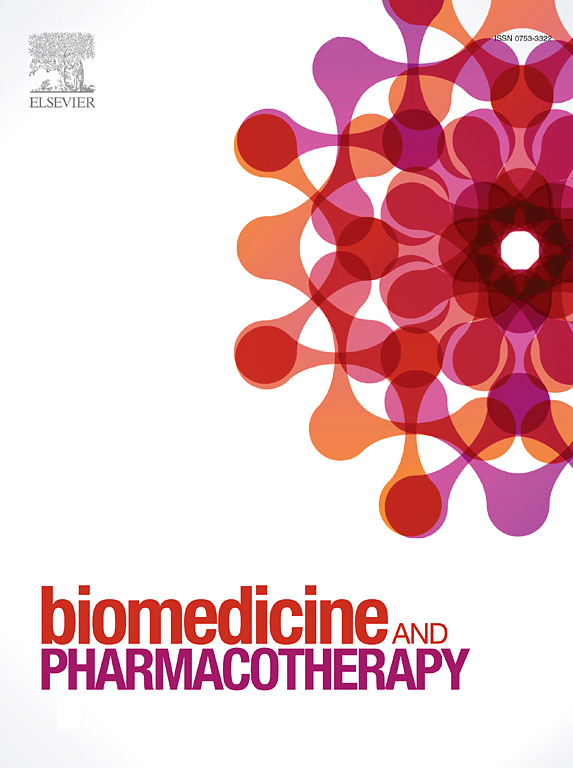Usnea longissima 的乙酸乙酯提取物对大鼠化疗相关多器官功能障碍的影响
IF 6.9
2区 医学
Q1 MEDICINE, RESEARCH & EXPERIMENTAL
引用次数: 0
摘要
背景:多柔比星和顺铂对不同器官的毒性作用与氧化应激有关。研究表明,Usnea longissima具有很强的抗氧化作用。本研究旨在探讨具有强抗氧化作用的长叶乌司他丁乙酸乙酯提取物(ULE)对化疗引起的心脏、肾脏、肝脏和卵巢毒性的保护作用:将白化 Wistar 雌性大鼠分为五组(每组 12 只):健康组(HG)、多柔比星组(DOX)、顺铂组(CIS)、多柔比星+ ULE 组(DULE)、顺铂+ ULE 组(CULE)。在本实验中,ULE 的口服剂量为 100 毫克/千克。1 小时后,腹腔注射 2.5 毫克/千克多柔比星和 2.5 毫克/千克顺铂。药物治疗每天一次,持续七天。七天后,每组六只大鼠安乐死,并对心脏、肾脏、肝脏和卵巢组织进行生化分析。剩下的大鼠与雄性大鼠一起留在实验室中繁殖 45 天:结果:ULE 可抑制化疗引起的肝脏、肾脏和卵巢组织中丙二醛、肿瘤坏死因子-α 和白细胞介素 6 的增加以及总谷胱甘肽的减少。ULE 还能抑制血清中血尿素氮、肌酐、丙氨酸氨基转移酶和天冬氨酸氨基转移酶的升高。ULE 对多柔比星和顺铂的心脏毒性没有保护作用。另一方面,ULE 还能减少化疗引起的妊娠延迟:结论:ULE 可作为化疗患者的辅助疗法,以减少肝脏、肾脏和卵巢的毒性。本文章由计算机程序翻译,如有差异,请以英文原文为准。
Effect of ethyl acetate extract from Usnea longissima on chemotherapy-associated multiple organ dysfunction in rats
Background
The toxic effects of doxorubicin and cisplatin in various organs have been associated with oxidative stress. Studies have shown that Usnea longissima has strong antioxidant effects. This study aimed to investigate the protective effect of ethyl acetate extract from Usnea longissima (ULE), which is known to have strong antioxidant effects, on chemotherapeutic-induced heart, kidney, liver, and ovarian toxicity.
Methods
Albino Wistar female rats were divided into five groups (12 rats per group): healthy (HG), doxorubicin (DOX), Cisplatin (CIS), Doxorubicin+ ULE (DULE), Cisplatin+ ULE (CULE). In this experiment, ULE was given 100 mg/kg orally. After 1 hour, 2.5 mg/kg doxorubicin and 2.5 mg/kg cisplatin were administered intraperitoneally. Drug treatments continued once a day for seven days. At the end of seven days, six rats from each group were euthanized and heart, kidney, liver, and ovary tissues were analyzed biochemically. The remaining rats were left in the laboratory with male rats for 45 days for reproduction.
Results
ULE inhibited chemotherapeutic-induced increase in malondialdehyde, tumor necrosis factor-alpha, and interleukin 6 and a decrease in total glutathione in liver, kidney, and ovarian tissues. ULE also inhibited the increase of blood urea nitrogen, creatinine, alanine aminotransferase, and aspartate aminotransferase in serum. ULE treatment had no protective effect against doxorubicin and cisplatin cardiac toxicity. On the other hand, ULE also decreased the delay in pregnancy induced by chemotherapy.
Conclusion
ULE may be considered an adjuvant therapy in patients receiving chemotherapy to reduce liver, kidney, and ovarian toxicity.
求助全文
通过发布文献求助,成功后即可免费获取论文全文。
去求助
来源期刊
CiteScore
11.90
自引率
2.70%
发文量
1621
审稿时长
48 days
期刊介绍:
Biomedicine & Pharmacotherapy stands as a multidisciplinary journal, presenting a spectrum of original research reports, reviews, and communications in the realms of clinical and basic medicine, as well as pharmacology. The journal spans various fields, including Cancer, Nutriceutics, Neurodegenerative, Cardiac, and Infectious Diseases.

 求助内容:
求助内容: 应助结果提醒方式:
应助结果提醒方式:


